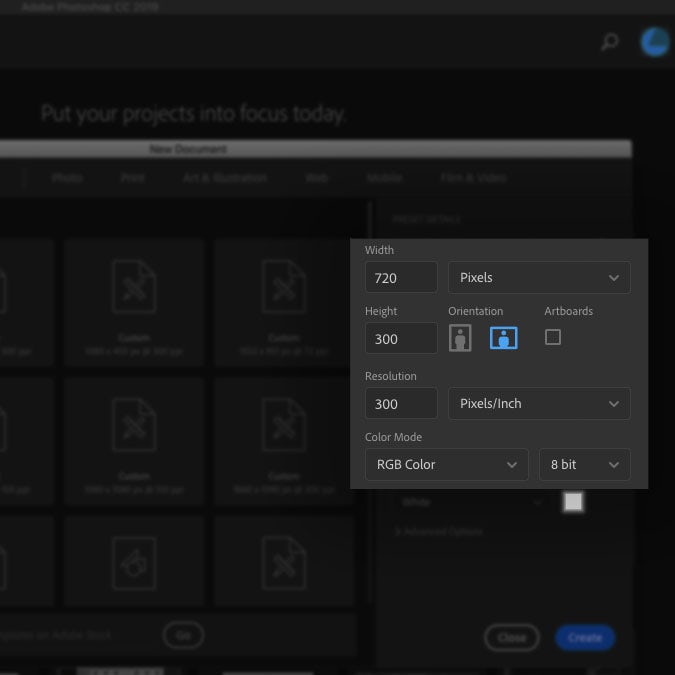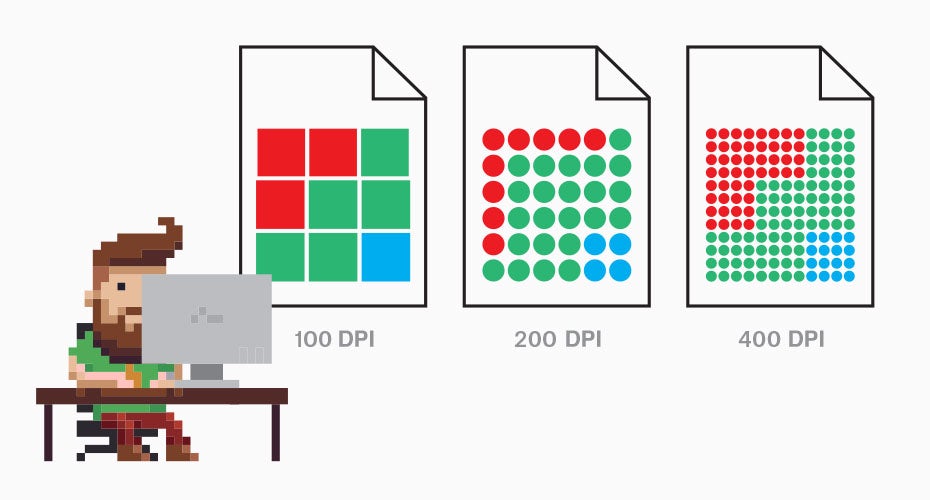When I Export My Pixel Art in Paint Net It Is Fuzzy
PPI and DPI are two important terms that anyone who works with images should know. Both define the resolution, or clarity, of an epitome but each refers to separate media—that is, digital versus print.
PPI and DPI are ofttimes used interchangeably when they shouldn't be. Agreement how they are different and how to employ each in your projects will empower y'all to produce a quality print, to optimize digital images for web and ultimately to relieve yourself valuable time. With that said, let'south deconstruct what these terms hateful and get into the differences between PPI and DPI.
What is the deviation between PPI and DPI?
—
PPI describes the resolution in pixels of a digital epitome whereas DPI describes the amount of ink dots on a printed image.
Though PPI largely refers to screen display, information technology also affects the print size of your design and thus the quality of the output. DPI, on the other manus, has nothing to do with annihilation digital and primarily concerns print.
PPI resolution
—
What PPI means
PPI, or pixels per inch, refers both to the fixed number of pixels that a screen can brandish and the density of pixels within a digital image. Pixel count on the other hand refers to the number of pixels across the length and width of a digital epitome—that is, the image dimensions in pixels. Pixels, or "picture elements", are the smallest edifice blocks of a digital image. Zoom in to any image on your and you will see it pause upwardly into colored squares—these are pixels.
Inside pixels are sub-pixels, reddish, green and blueish light elements that the homo eye cannot see considering additive color processing blends them into a unmarried hue which appears on the pixel level. This is why PPI utilizes the RGB (red, green and blueish) color model, as well known equally the additive colour model. This does not be in print—just in the electronic display of images, like boob tube screens, estimator monitors and digital photography.
When exercise you use PPI?
Use PPI whenever you are working with digital images. PPI is well-nigh useful in preparing files for printing (though DPI volition be used by the physical printer—run across more in the DPI department below). An epitome with a higher PPI tends to be higher quality because information technology has a greater pixel density, merely exporting at 300 PPI is generally considered industry standard quality.
Because increasing the PPI increases the size of your file, you will desire to employ a high PPI merely when necessary. For example, when printing involves many fine details on a glossy surface, it's best to consider using a higher resolution. Printing an image on canvas does not require equally high a resolution because details go lost in the texture of the fabric. PPI does not actually affair for distribution on the spider web considering the pixel density of your monitor is fixed. A 72 PPI image and a 3,000 PPI image will appear the same on your screen. It is the pixel dimensions (the amount of pixels from left to right, top to bottom) that will determine the size and detail of your paradigm.
How to set up or change PPI resolution

Raster programs (software that work with pixel-based media) like Photoshop take y'all fix the PPI resolution right at the beginning when y'all create a document. You lot will find Resolution listed with other parameters in the New Document window.
If y'all demand to increment the resolution on an image that has already been created, you can resample information technology. Resampling is the process of changing the amount of pixels in an prototype, in which the software volition create or delete pixels to preserve prototype quality.
In Photoshop, yous can do this by navigating to Image > Image Size. In the Image Size window, you lot will have options for changing the width, height and PPI resolution of your image. Select the "Resample" checkbox and set up it to "Preserve Details" to cull how Photoshop fills in the new pixels.

You can decrease the resolution if y'all ready the PPI to a lower value. As the pixel count decreases, the epitome size and dimensions decrease besides. You increase the resolution when you set PPI to a higher value. This allows the image to be printed at a larger print size.
That said, it is best to avoid irresolute the PPI on an existing paradigm whenever possible. The resampling process requires Photoshop to generate new pixels from scratch. While Photoshop is able to read the surrounding pixels and make a somewhat accurate guess as to what color each new pixel should be, computers are notoriously bad at "seeing" images the way humans can. Thus, computer generated pixels can create unintentional results on your image.
DPI press
—
What DPI means
DPI, or dots per inch, refers to the resolution value of a physical printer. Printers reproduce an image by spitting out tiny dots, and the number of dots per inch affects the amount of particular and overall quality of the impress.
DPI uses the CMYK (cyan, magenta, yellowish and central/black) color model to control the amount of red, green, and blueish light that is reflected from white paper. This is likewise known as the subtractive color model. Dots of each color are printed in patterns, enabling the human heart to perceive a specific color made from this combination. DPI is a measurement of this density. These dots are a fixed size and resolution is merely affected by how many dots appear per inch.
When do you employ DPI?
When your design is going to be physically printed, the printer will use DPI. Each model and fashion of printer produces its ain unique DPI based on its settings. Inkjet printers produce a resolution around 300 to 720 DPI, while laser printers produce images anywhere from 600 to 2,400 DPI.

At that place is no standard dot size or shape, then college DPI does non always equate to a college quality print. One manufacturer's dots might look as skilful at 1200 DPI as another manufacturer's dots do at 700 DPI. Books and magazines often utilise 150 DPI for photographic reproduction, and newspapers often use 85 DPI. Inquire the printshop or consult the printer specifications to find the appropriate DPI for your projection.
Image resolution matters
—
Knowing how to use PPI will empower you to produce high quality images every time. And knowing how to navigate DPI volition help y'all to finer communicate with printing machines and professionals in the printing industry. Unless y'all are a printer, your main focus volition be on PPI. But it is of import to understand the process of physical printing if your piece of work requires it on a regular basis.
In the cease, fifty-fifty the best design can exist ruined by a poor image resolution. That'south why if yous want crystal clear quality in your designs, brand sure you're working with a professional designer.
Bank check out this article on graphic design basics for more design knowledge.
Want picture perfect resolution in your pattern projects?
Notice a designer today!
This article was originally written by Alex Bingman and published in 2013. It has been updated with new examples and information.
weaverwhismainfits74.blogspot.com
Source: https://99designs.com/blog/tips/ppi-vs-dpi-whats-the-difference/
Отправить комментарий for "When I Export My Pixel Art in Paint Net It Is Fuzzy"